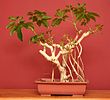Schefflera arboricola
| Schefflera arboricola | |
|---|---|

| |
| Scientific classification | |
| Kingdom: | Plantae |
| Clade: | Tracheophytes |
| Clade: | Angiosperms |
| Clade: | Eudicots |
| Clade: | Asterids |
| Order: | Apiales |
| Family: | Araliaceae |
| Genus: | Schefflera |
| Species: | S. arboricola
|
| Binomial name | |
| Schefflera arboricola | |
| Synonyms | |
|
Heptapleurum arboricolum | |
Schefflera arboricola is a flowering plant in the family Araliaceae, native to Taiwan and Hainan Province, China.[1][2] Its common name is dwarf umbrella tree, as it resembles a smaller version of the umbrella tree, Schefflera actinophylla. Current taxonomy places both species in the genus Heptapleurum.[3]
Description[]

It is an evergreen shrub growing to 8–9 m tall, free-standing, or clinging to the trunks of other trees as an epiphyte. The leaves are palmately compound, with 7–9 leaflets, the leaflets 9–20 cm long and 4–10 cm broad (though often smaller in cultivation) with a wedge-shaped base, entire margin, and an obtuse or acute apex, sometimes emarginate.[1][2] The leaves are leathery in texture, shiny green, glabrous on the upper surface and somewhat lighter and matte on the underside. Young plants have smaller leaves and fewer leaflets. Each leaflet has a central rib that divides it into two halves, with between four and six ribs clearly visible up to the third order. The stipules merge with the petiole, the length of which is 12-15 cm.[4]
Flowers[]
Appearing from midsummer to early autumn, the flowers are produced in a 20 cm panicle of small umbels, each umbel 7–10 mm in diameter with 5–10 flowers.[1] The flowers are hermaphroditic, having a colour ranging from yellow to green and a double perianth radial symmetry. They are composed of an entire annular calyx, five almost fully developed sepals, a corolla with five petals 2.5 mm long, with five stamens and five or six carpels that enclose the ovary. The style is not recognizable and the stigma is established.[2]
Fruits[]
The fruits have an almost spherical oval drupe, with a diameter of about 5 mm. The endocarp contains five seeds. The fruits ripen from late summer to early winter. They begin as orange glandular points. At maturity, they become red-violet.
Cultivation and uses[]
Schefflera arboricola is commonly grown as a houseplant, popular for its tolerance of neglect and poor growing conditions. It is also grown as a landscape (garden) plant in milder climates where frosts are not severe. Numerous cultivars have been selected for variations in leaf colour and pattern, often variegated with creamy-white to yellow edges or centres, and dwarf forms. The cultivar 'Gold Capella' has gained the Royal Horticultural Society's Award of Garden Merit.[5][6]
Poisoning[]
Schefflera poisoning is due to the species containing "sharp" calcium oxalate crystals that are insoluble and damage the cells and tissues of the animals ingesting them. For their own safety, children and household pets should be kept away from consuming this plant. In animals, the resulting damage (swelling) of exposed tissues and digestive tract may be fatal to the animal.[citation needed] Signs of poisoning in pets can include: oral irritation, intense burning and irritation of the mouth, lips, tongue, excessive drooling, vomiting, difficulty in swallowing.[7]
Care[]
The plant prefers higher light if possible, but can adapt to a wide variety of light levels. As a tropical plant it likes moisture (and humidity), but avoid letting the plant sit in water after you water it. It likes to be moist but not wet so just let the soil dry out between waterings.
Aerial roots[]
Under the right conditions, this plant will produce aerial roots that, when they reach the ground, will convert to fully functional roots. They give the plant an unusual and interesting appearance. Three conditions must be maintained for the plant to produce them: a high growth rate, insufficient trunk roots (the plant is root bound or these roots are pruned) and constant, very high humidity.
Photo gallery[]

A bonsai from New England.

A variegated cultivar

An old indoor bonsai presented as a penjing

Soon after branch pruning, to demonstrate aerial roots

A garden plant with fruits in Maui
References[]
- ^ a b c Ohashi, Hiroyoshi (1993). "Araliaceae". In Huang, Tseng-chieng (ed.). Flora of Taiwan. Vol. 3 (2nd ed.). Taipei, Taiwan: Editorial Committee of the Flora of Taiwan, Second Edition. p. 1002. ISBN 957-9019-41-X. Retrieved 14 March 2013.
- ^ a b c Qibai Xiang & Porter P. Lowry. "Schefflera arboricola". Flora of China. Missouri Botanical Garden, St. Louis, MO & Harvard University Herbaria, Cambridge, MA. Retrieved 14 March 2013.
- ^ "Schefflera arboricola". Germplasm Resources Information Network (GRIN). Agricultural Research Service (ARS), United States Department of Agriculture (USDA).
- ^ Russ, Karen; Pertuit, Al. "Schefflera". Clemson Cooperative Extension Home & Garden Information Center. Retrieved 5 May 2020.
- ^ "Schefflera arboricola 'Gold Capella'". RHS. Retrieved 5 March 2021.
- ^ "AGM Plants - Ornamental" (PDF). Royal Horticultural Society. July 2017. p. 95. Retrieved 5 November 2018.
- ^ "Schefflera". ASPCA. Retrieved 2022-01-03.
External links[]
- Fukubonsai, information about Schefflera arboricola as indoor bonsai.
- Schefflera
- Flora of China
- Flora of Taiwan
- Medicinal plants
- House plants
- Plants used in traditional Chinese medicine
- Plants used in bonsai
- Taxa named by Bunzō Hayata




